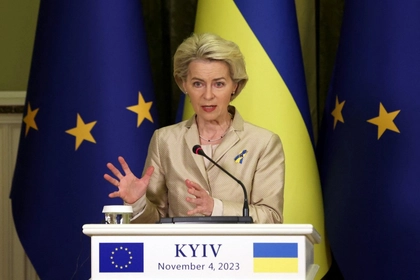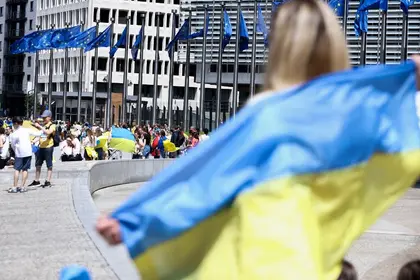The European Commission on June 17 approved Ukraine’s application for EU membership, and on June 23, the European Parliament adopted a historic resolution in support of granting Ukraine EU membership candidate status. The decision was confirmed at the European Council summit, which followed.
For the opportunity to finally become part of the European family, thousands of Ukrainians rallied during the Revolution of Dignity (also known as Euromaidan, which took place largely over the winter of 2013-14) and are now defending the country from Russian aggression.
JOIN US ON TELEGRAM
Follow our coverage of the war on the @Kyivpost_official.
This status opens up opportunities for Ukraine to attract additional funding, while at the same time being an incentive to carry out the necessary reforms during the war.
New opportunities
The candidacy creates six new opportunities for Ukraine:
- legal consolidation of Ukraine’s European future;
- completion of the comprehensive transformation of all spheres of life with the support of the European Commission;
- full participation in EU programs and initiatives;
- achieving attractiveness for investors and security for business;
- gaining access to financial assistance for countries preparing to join the EU (grants, investments or technical assistance).
During the war, it’s important for business that access to the EU market will be improved and simplified. Many steps are being taken now, and after having obtained candidate status, this work can be accelerated even more.
Candidate status for Ukraine means that one day it will become a full member of the European Union, with at least the image component of our country improving significantly. This means that in the future we will have a predictable environment and a clear direction of development while creating new investment opportunities for us.
The issue of investment is not a matter of 1-2 years, but rather of 5-10 years, since investors begin to look at the candidate country and its markets in a completely different way. Investors understand that in a few years this market will become part of a much larger market – one without restrictions. However, in the short term, more opportunities arise for getting wider access to EU programs and funds.

EU Transfers €1.5 Bln Raised From Russian Assets for Ukraine
EU financial aid
The experience of Central and Eastern European countries shows that in the pre-accession period, the GDP of the candidate country begins to grow.
In particular, even before accession, Poland received funding through three programs: PHARE, SAPARD and ISPA. In the first 10 years under the programs, Poland received the equivalent of more than 2 billion euros.
Since 2007, the European Union has moved to a single pre-accession financial assistance instrument, the IPA (Instrument for Pre-Accession Assistance), which aims to support reforms through financial and technical assistance.
Such assistance can be provided through grants, investments, or as technical assistance for seven years (as per the third version of the IPA – from 2021 to 2027). During this period, the total amount of IPA expenditures is about 14.2 billion euros. Its main goal is divided into five thematic priorities:
- strengthening the rule of law, democracy, the protection of human rights and fundamental freedoms;
- effective public administration, including in the field of public procurement and state aid;
- the “green” agenda;
- competition and comprehensive economic growth, a focus on small and medium enterprises for agricultural and rural development;
- territorial and cross-border cooperation.
In addition to funds from the IPA instrument, Ukraine can access individual financial support programs and projects of the European Union.
For example, in 2014, the so-called Berlin Process was launched, which aimed to unite the markets of the six countries of the Western Balkans and, further, to unify them with the market of the European Union.
Given the conditions in which Ukraine acquired candidate status, separate mechanisms of financial support will be developed for our country with an emphasis on the restoration of damaged and destroyed infrastructure.
Ukraine’s reconstruction plan
The European Commission, together with the Cabinet of Ministers, is considering the strategic plan, Reconstruction of Ukraine. This plan outlines the key reforms and investments needed to build a prosperous and sustainable future for Ukraine.
The Reconstruction of Ukraine program will be the main legal instrument for the European Union to support the reconstruction plan through a combination of grants and loans. This will be enshrined in the EU budget, thus ensuring transparency, accountability and the sound financial management of this initiative.
Reconstruction includes all industries, each of which has its own specifics, so the task of infrastructure is to provide integrated solutions for transport connections and high mobility.
Currently, the following main areas of reconstruction can be identified:
- rebuilding the country, including infrastructure, medical facilities, housing and schools, as well as the digital and energy sectors in line with European standards;
- continuing the process of modernizing the state and its institutions to ensure proper governance and respect for the rule of law;
- agenda implementation to deepen the economic and social integration of Ukraine and its people into the EU;
- rebuilding Ukraine’s economy and society, promoting sustainable and inclusive economic competitiveness, sustainable trade and private sector development, while promoting the country’s green transition and digitalisation.
EU funding is not provided after the acquisition of candidate status, but with the opening of negotiations on a roadmap or action plan to meet the requirements for EU membership. According to preliminary estimates, Ukraine will need to pass more than 70 laws in the short term, and overall, close 35 chapters provided for in the Association Agreement.
What needs to be done in the field of transport?
- Open skies – implementation of the Common Aviation Area Agreement;
- No permits for trucks – signing the Agreement on the Liberalization of International Road Transport
- Adoption of the draft law on railway transport and the unbundling of Ukrzaliznytsia (Ukrainian Railways) into three operators – of infrastructure, freight and passenger transportation
- Implementation of legislation on inland waterways and development of river transport on the Dnipro and Danube
Funding from the EU is not provided after the acquisition of candidate status, but with the opening of negotiations on a roadmap or action plan to meet the requirements for EU membership. Therefore, the Recovery Plan of Ukraine, with its list of reforms, will be approved first, and funds will be allocated for this plan.
The timing of Ukraine’s membership will depend on the pace of the country’s reform progress; on average, countries become EU members after eight years as a candidate.
At the same time, Ukraine has a certain advantage: since 2014, the Association Agreement has prepared us for economic integration. Here, Ukraine is much better prepared than other countries with candidate status.
Therefore, if we take steps toward the EU in terms of reform, it will be realistic to become an EU member in five years.
Viktor Dovhan, Transport expert, Deputy Minister of Infrastructure, 2016 – 2019.
Disclaimer: The views expressed in this opinion piece are the author’s and not necessarily those of the Kyiv Post.
You can also highlight the text and press Ctrl + Enter






